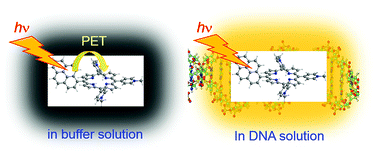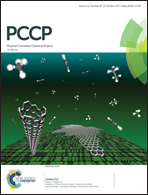Relationship between the photoinduced electron transfer and binding modes of a pyrene–porphyrin dyad to DNA
Abstract
The binding modes of a pyrene–porphyrin dyad, (1-pyrenyl)-tris(N-methyl-p-pyridino)porphyrin (PyTMpyP), to DNA and its photophysical properties have been investigated using various spectroscopic techniques. The circular dichroism (CD) spectrum of PyTMpyP bound to DNA (PyTMpyP–DNA) showed one negative and two positive bands in the Soret region. The CD signal in the pyrene absorption region was positive. The shape of the CD spectrum does not support an intercalative binding mode of TMpyP, which would typically afford a negative CD band in the absence of the pyrene moiety. Linear dichroism (LD) experiments revealed a very small signal in the Soret region, which also challenges the intercalation of TMpyP into DNA. Upon excitation of the pyrene moiety, the emission intensity of porphyrin in aqueous solution was quenched due to a photoinduced electron transfer (PET) process between the pyrenyl and porphyrin moieties. On the other hand, the emission of porphyrin was markedly enhanced upon binding to DNA, as the PET process from the excited pyrene moiety to TMpyP was suppressed when bound to DNA. The PET process occurs in the timescale of 65 ps, and could be detected by femtosecond transient absorption spectroscopic methods. Two fluorescence decay times were observed for PyTMpyP in aqueous solution (0.78 and 4.8 ns). Both decay times increased upon binding to DNA owing to environment and/or conformational changes in PyTMpyP. The driving force (ΔG) of the PET process was evaluated under conditions of minor and major groove binding. The PET process and photophysical properties of the PyTMpyP dyad were concluded to be influenced by the binding mode.



 Please wait while we load your content...
Please wait while we load your content...